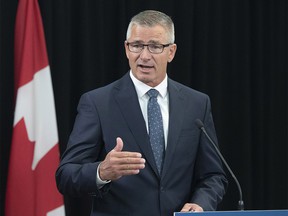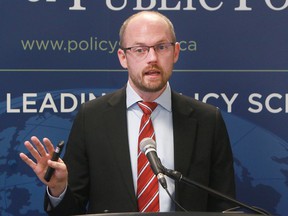
Two numbers in the new annual report of ATB Financial neatly capture how quickly the economic tide has turned in Alberta over the past 24 months.
The first number, $586 million, is ATB’s net income for the year that ended March 31. On Thursday, the provincial Crown corporation reported record financial results for the fiscal year, more than double last year’s performance.
It’s also a whopping 475 per cent jump from 2020 levels, when the pandemic sent Alberta’s economy into a sudden tailspin.
The second key number to consider — $204 million — helped propel net income to new heights in the past year.
ATB increased its loan loss provisions early in the pandemic due to the recession and financial stress being felt across the province, but the situation has reversed. The corporation reported Thursday a $204-million recovery of loan loss provisions as the credit quality of customers improved, said ATB Financial CEO Curtis Stange.
“We had the best year ever as a company, came out of a pandemic with a stronger balance sheet, a more diversified income statement . . . with each quarter, we saw some really good progress,” Stange said in an interview.
“We did have some reversals to previous loan provisions that we made and that had a pretty material impact on the bottom line.”
The improvement in expected loan losses helps illustrate a broader financial turnaround now taking place across the province.
After the pandemic hit in early 2020, oil and gas prices tanked as global energy demand plummeted. Many businesses closed and thousands of Albertans lost their jobs.
The provincial economy shrank by 7.9 per cent in 2020, the worst contraction in the country. ATB recorded a 14 per cent jump in loan loss provisions that year.
However, the economy has snapped back with surging commodity prices, stronger housing markets and growing retail sales.
Businesses reopened as pandemic restrictions have been lifted. Employment levels have come back. Insolvencies in the province fell by 4.7 per cent in March from levels a year earlier.
“There’s a connection between the strength of the Alberta economy and, typically, the results at ATB . . . and these are very encouraging results,” Finance Minister Travis Toews said in an interview.
“Here’s the reality: $586 million, effectively, will go straight to the government of Alberta’s bottom line, and that goes to the bottom line of Albertans.”

More broadly, the economic outlook for 2022 is improving, although some wild cards remain on the table.
The latest outlook from the Conference Board of Canada has Alberta leading the country with 5.3 per cent economic growth this year. S&P Global Ratings recently raised its long-term credit rating for the province to A+ from A, which Toews noted is the first upgrade Alberta has seen since 2001.
“The stable outlook reflects our expectation that Alberta’s budgetary performance will remain stronger than in the past years, as a result of robust economic growth and high oil prices,” S&P analyst Stephen Ogilvie said in a report last week.
During the 2022 fiscal year, ATB’s revenue jumped by seven per cent to a record $1.9 billion. Net loans increased three per cent to $45.9 billion, reflecting positive momentum in Alberta’s economy, according to the corporation’s annual report.
And since the third quarter of 2021, ATB’s “recovery of loan losses has increased as the economic outlook has improved. The health of our loan portfolio has been bolstered with impaired loans returning to performing and loans being paid down,” the report states.
University of Calgary economist Trevor Tombe noted other financial institutions are also reporting strong results and making progress in their provisions for credit losses as the Canadian economy has bounced back from the depths of the pandemic.
“We are seeing this in bank after bank . . . and what that tells us is we’ve recovered much more strongly from COVID than anyone reasonably expected last year,” Tombe said.
“Seeing that here with ATB continues that broad trend. And it’s not just an economic story but a fiscal one as well, because the government of Alberta is the owner of ATB — and so higher earnings translate directly into increased revenues to the province.”

Looking forward, ATB expects the provincial economy will expand by five per cent in 2022, and then grow by 3.5 per cent next year. The forecast is based on prices for benchmark West Texas Intermediate crude averaging US$95 a barrel this year and $86 in ’23.
“The energy price and the economic recovery in Alberta happened faster than what we would have projected,” said Stange. “There’s no doubt that energy still acts as a pretty meaningful catalyst to the provincial economy.”
The economic recovery in Alberta is more broadly based than just energy, as ATB saw strong performance from its commercial real estate portfolio and agriculture remained steady, he said.
At an ATB-hosted business summit in Edmonton, the organization’s chief economist Todd Hirsch said Thursday that several factors will affect the economy in 2022, including Russia’s invasion of Ukraine, rising inflation and higher interest rates.
Alberta is in the second year of a rebound coming off the 2020 recession and it will likely take until later this year for the economy to fully return in size to where it was before the pandemic, he noted.
“We’ve come a long way in digging ourselves out of that hole, but we’re hoping for more balanced, maybe more moderate, growth in 2023,” added Hirsch.
Chris Varcoe is a Calgary Herald columnist.
You can read more of the news on source
